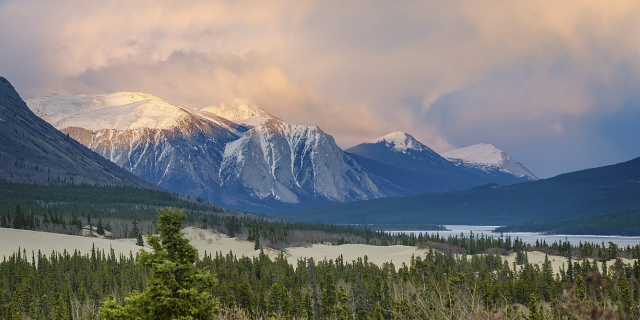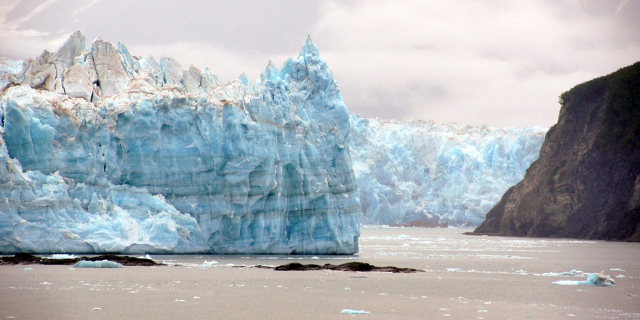Nahanni National Park Reserve
Nahanni National Park Reserve in the Dehcho Region of the Northwest Territories, Canada, approximately 500 km (311 mi) west of Yellowknife, protects a portion of the Mackenzie Mountains Natural Region. The centrepiece of the park is the South Nahanni River (Naha Dehé). Four noteworthy canyons reaching 1,000 m (3,300 ft) in depth, called First, Second, Third and Fourth Canyon, line its whitewater river. The name Nahanni comes from the indigenous Dene language name for the area; Nahʔa Dehé, which means "river of the land of the Nahʔa people".: 87 The park was among the world's first four natural heritage locations to be inscribed as World Heritage Sites by UNESCO in 1978 because of its picturesque wild rivers, canyons, and waterfalls.
 The Gate, Second Canyon
The Gate, Second Canyon Mason's Rock in the centre of Virginia Falls
Mason's Rock in the centre of Virginia FallsThe Dene, sometimes called Slavey peoples, have used the lands around Nahanni National Park Reserve for thousands of years. The first human occupation of the area is estimated to have occurred 9,000-10,000 years ago. Evidence of prehistoric human use has been found at Yohin Lake and a few other sites within the park. The local oral history contains many references to the Naha tribe, a mountain-dwelling people who used to raid settlements in the adjacent lowlands. These people are said to have rather quickly and mysteriously disappeared.[1]
First contact with European fur traders expanding into the region occurred in the 18th century, and was increased with Alexander Mackenzie's exploration of the Mackenzie River (Deh Cho), and building of trading posts at Fort Simpson and Fort Liard. At both of these John McLeod, a Scottish explorer of the area, was to serve as manager.[2] During the 19th century, most Dene families left their nomadic lifestyles and settled into more permanent communities, often close to the trading posts. Permanent settlements were established at locations such as Nahanni Butte, Fort Liard and Fort Simpson.[1]
In the late 19th century, the Mountain Indians of the Nahanni region would travel down the Nahanni River each spring in mooseskin boats to trade the winter take of furs. These boats, based on the York boats used by the Hudson's Bay Company, were up to 20 m (66 ft) in length. Constructed from six to ten untanned moose hides sewn together and stretched over a spruce pole frame, these boats would transport entire families, their dogs and cargo of furs down the river during high water. Upon arrival the boat was dismantled and the hides traded along with the furs. Following a visit to the forts, these people would return to the high country with only what they could carry on their pack dogs.[1]
The stories of the Naha, and dangerous landscape that they inhabited, grew in stature with the Klondike Gold Rush as some explorers attempted to use the Nahanni as a path to the famous gold fields of the Yukon, or to try and make their fortune on the Flat and South Nahanni Rivers. Although no significant gold was recovered, legends of haunted valleys and lost gold emerged after the headless corpses of Métis prospectors Willie and Frank McLeod were found around 1908. The Lost McLeod Mine, a legendary lost mine somewhere in the park, is supposed to have been where the two brothers found their gold.[3] In the years that followed, mysterious deaths of other prospectors added to the legends. Alternative names given to the park, which include Deadmen Valley, Headless Creek, Headless Range and the Funeral Range, bear testimony to these stories and legends.[1] In later years, Albert Faille was a prospector in the area and met writer Raymond M. Patterson. The latter's works brought minor fame to Faille.[4]
In 1946 Calgary geologist and mining expert Frank M. W. Henderson returned from the valley reporting his partner John Patterson had disappeared.[5] Henderson and Patterson had agreed to meet at a point near Virginia Falls. The first to arrive would leave a message on a large tree which both knew from previous trips. Henderson arrived first and left his message before traveling into the valley. He returned several weeks later only to find there was still no message left by Patterson. Henderson and his party camped there a few days, but one night were awoken by a group of First Nations people who warned of white figures moving along the valley.
In 1947 author Pierre Berton was sent by The Vancouver Sun to cover the north. He, along with pilot Russ Baker, flew up the Headless Valley. Writing on his journey for Macleans Berton remarked, "Frank Henderson himself, a man who perhaps has good reason not to want too many people rushing into the valley, was quoted as saying, on his return from the area last fall, 'There is absolutely no denying the sinister atmosphere of that whole valley. The weird, continual wailing of the wind is something I won't, soon forget.'"[6]
In 1964, explorer parachutist Jean Poirel from Montreal jumped at its source 500 km (310 mi) north of Yellowknife, followed by his teammate Bertrand Bordet. Jean Poirel imagined the idea of going down the river with inflatable dinghies. During the following four consecutive expeditions in the valley Jean Poirel discovered more than 250 caverns. The most important contained 116 Dall sheep's skeletons (carbon-14 dated to 2500 years BC); Jean Poirel named it "Valerie Cavern" after his daughter. He took topographic notes and drew detailed maps, paving the way for the park's creation. During his last expedition in 1972, he escorted Pierre Trudeau, who came to evaluate the region.[7][8]
Park historyOriginally established in 1972, by then Prime Minister Pierre Elliot Trudeau,[9] the park was 4,766 km2 (1,840 sq mi) in area.[10] The park was in "reserve" status pending settlement of outstanding Aboriginal land claims in the region. In 2003, an agreement between the Dehcho First Nations and Parks Canada gave temporary protection to 23,000 km2 (8,880 sq mi).[9] In August 2007, the federal government added an extra 5,400 km2 (2,085 sq mi).[11]
In a novel form of cooperation between federal government and native groups, the Naha Dehe Consensus Team was formed in June 2000 by Canada and the Dehcho First Nations.[12] Their original main tasks included:
prepare an Ecological Integrity Statement, complete a review of the Park Management Plan, prepare an Interim Park Management Arrangement, and prepare a Memorandum of Understanding Respecting Park Expansion.In 2003, these were completed and the purpose of the team changed, now dealing with cooperative management issues, according to the Interim Park Management Arrangement, until the Dehcho Process is completed.[12][13]
On 9 June 2009 the Government of Canada, with the Dehcho First Nations, announced legislation that will increase the area of Nahanni National Park to cover 30,050 km2 (11,602 sq mi), including 91% of the Greater Nahanni ecosystem in the Dehcho Region and most of the South Nahanni River watershed.[14]
The new park area is estimated to be the home of around 500 grizzly bears, two herds of woodland caribou, as well as species of alpine sheep and goats and other species. The new boundary will include the highest mountains and largest ice fields in the Northwest Territories.[15] With the expansion of the park there have been several added designated landing sites. Because most access to the park is done by aircraft and air access is restricted in the park, there are set places aircraft can land. Before the expansion these were limited to Virginia Falls and Rabbitkettle Lake. Now there are five more: the Bunny Bar, Island Lake, Honeymoon Lake, Glacier Lake, and Seaplane Lake. However, only Virginia Falls and Glacier Lake are designated for day use visitation, meaning all other sites require visitors to stay overnight in the park.[16]
A visitor centre in Fort Simpson features displays on the history, culture and geography of the area. The park was among the world's first four natural heritage locations to be inscribed as World Heritage Sites by UNESCO in 1978.[10] The South Nahanni River achieved Canadian Heritage River status in 1987. Presently around 800–1000[16]: 11 people visit the park every year, most of which are overnight visitors who travel down the South Nahanni. The park is open year-round, but most visitors come in June, July, and August. Virginia Falls is the only area of the park where a reservation is required, which must be done months in advance to prevent overcrowding. For safety reasons, all visitors must register with park officials upon entering the park boundaries, and deregister within 24 hours of leaving. There is a park office in Nahanni Butte at the end of the river, where visitors can deregister.[17] The only practical way to get to Nahanni National Park is by floatplane or by helicopter, usually from Fort Simpson but other communities and locations offering a gateway into the park include: Watson Lake, Muncho Lake, Fort Nelson and Inconnu Lodge.[16] Some people do hike in from the Nahanni Range Road at Tungsten to the west of the park.
In 2007 the park was voted one of the Seven Wonders of Canada in a competition sponsored by CBC Television's The National and CBC Radio One's Sounds Like Canada.[18] The park was the subject of a short film in 2011's National Parks Project, directed by Kevin McMahon and scored by Shad, Jace Lasek and Olga Goreas.































Add new comment